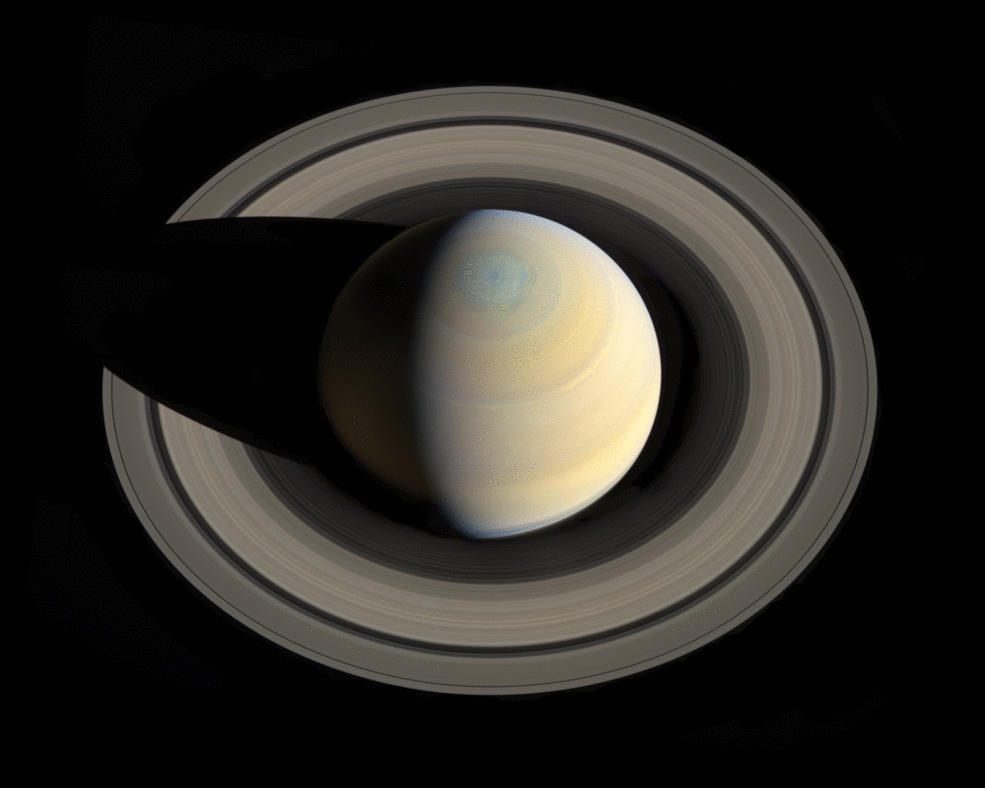NASA’s recent research has confirmed that Saturn is experiencing a significant depletion of its iconic rings, with the rate of loss aligning with the highest estimates derived from observations made by Voyager 1 and 2 several decades ago. This fascinating phenomenon, known as ‘ring rain,’ occurs when Saturn’s gravitational pull attracts ice particles from its rings, influenced by the planet’s magnetic field.
According to James O’Donoghue, a researcher at NASA’s Goddard Space Flight Center in Greenbelt, Maryland, this process results in the drainage of water products equivalent to filling an Olympic-sized swimming pool from Saturn’s rings in just half an hour. O’Donoghue, who is the lead author of a study published in Icarus, further explained that based on this estimation alone, the entire ring system will disappear in approximately 300 million years. However, when taking into account the additional contribution from ring-material detected by the Cassini spacecraft falling into Saturn’s equator, it is expected that the rings will vanish in less than 100 million years. This timeframe is relatively short compared to Saturn’s age of over 4 billion years.
The study sheds light on the formation of Saturn’s rings, suggesting that they likely originated later in the planet’s lifespan rather than being present since its formation. The research indicates that the rings are probably not older than 100 million years, as it would have taken that long for the C-ring to reach its current density if it was once as dense as the B-ring. O’Donoghue noted, “We are fortunate to witness Saturn’s ring system, which appears to be in the middle of its life cycle. However, if rings are indeed temporary, we may have missed observing the massive ring systems of Jupiter, Uranus, and Neptune, which now only have thin ringlets.”

The initial suggestion of the existence of ring rain came from Voyager observations of seemingly unrelated phenomena. These included variations in Saturn’s ionosphere, density fluctuations in its rings, and dark bands encircling the planet’s northern mid-latitudes. The dark bands were first noticed in images of Saturn’s upper atmosphere taken by NASA’s Voyager 2 mission in 1981.
In 1986, Jack Connerney from NASA Goddard proposed a connection between these dark bands and Saturn’s magnetic field. He suggested that electrically charged ice particles from the rings were flowing along invisible magnetic field lines, depositing water in Saturn’s upper atmosphere. This influx of water, which occurred at specific latitudes, caused the stratospheric haze to become obscured, resulting in the dark bands observed in the Voyager images.
Saturn’s rings are primarily composed of water ice particles that range from microscopic dust grains to boulders several yards across. These particles are maintained in a delicate equilibrium between Saturn’s gravitational pull, which pulls them inward, and their orbital velocity, which pushes them outward. When these particles become electrically charged, either due to sunlight or plasma clouds from micrometeoroid impacts, they can be influenced by Saturn’s magnetic field and drawn into the planet’s upper atmosphere along magnetic field lines.
Upon reaching the upper atmosphere, the icy particles vaporize, and the water chemically reacts with Saturn’s ionosphere, resulting in the formation of H3+ ions. When these ions are energized by sunlight, they emit infrared light, which was observed by O’Donoghue’s team using instruments attached to the Keck telescope in Hawaii.
The team’s observations unveiled glowing bands in Saturn’s northern and southern hemispheres, corresponding to areas where the magnetic field lines intersect the ring plane and enter the planet. These bands offer insights into the amount of ring rain and its impact on Saturn’s ionosphere. Furthermore, a glowing band at a higher latitude in the southern hemisphere indicates that water particles from the geologically active moon Enceladus also contribute to the ring rain.
Researchers are keen on investigating how ring rain changes with Saturn’s seasons, as the planet’s exposure to sunlight influences the charging of ice grains and their reaction to the magnetic field.
The research was funded by NASA and the NASA Postdoctoral Program at NASA Goddard, with observations carried out using the W.M. Keck Observatory in Hawaii. The authors also recognize the cultural importance of Mauna Kea within the indigenous Hawaiian community.
Do not forget to share your opinion with us to provide you with the best posts !




0 Comments